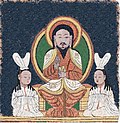Gallery
- Fragment of Uyghur Manichaean hanging scroll "MIK III 6251"
- Manichaean temple banners "MIK III 6286" and "MIK III 6283"
- Reconstruction of the Light Maiden image on the Manichaean banner "MIK III 6286"
- Reconstruction of the Jesus image on the Manichaean banner "MIK III 6286"
- Leaf from a Manichaean book "MIK III 4959"
- Leaf from a Manichaean book "MIK III 4965"
- Leaf from a Manichaean book "MIK III 4979" recto
- Leaf from a Manichaean book "MIK III 4979" verso
- Leaf from a Manichaean book "MIK III 6368" recto
- Leaf from a Manichaean book "MIK III 6368" verso
- Leaf from a Manichaean book "MIK III 8259" folio 1 recto
- Fragment of a Manichaean textile display "MIK III 6278"
- Fragment of a Turfan Manichaean wall painting "MIK III 6918"












